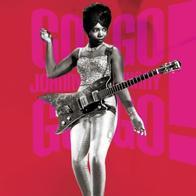Go Johnny Go!
dal 22/10/2003 al 7/3/2004
Segnalato da
John Armleder
Jennifer Bolande
Uros Djuric
Rainer Fetting
Barnaby Furnas
Rodney Graham
Lori Hersberger
Cameron Jamie
Seydou Keita
Martin Kippenberger
Paul Albert Leitner
Franziska Maderthaner
Christian Marclay
Helmut Middendorf
Mike Abetz
Oliver Drescher
Mathias Poledna
Lee Ranaldo
Gerwald Rockenschaub
George Segal
Sonic Youth
Steven Shearer
Malick Sidibe
Thaddeus Strode
Jeff Wall
Hans Weigand
Franz West
Ernest B. Withers
Heimo Zobernig
Wolfgang Kos
Thomas Miessgang
22/10/2003
Go Johnny Go!
Kunsthalle Wien, Wien
The Electric Guitar - Art and Myth. The guitar and more could be the leitmotif of the exhibition Go Johnny Go. The significance of the electric guitar has always gone beyond that of an instrument used solely for music making. Through the lens of the fine arts, Go Johnny Go attempts to provide a panorama view of an instrument that in the last 50 years has not only shaken music, but also the self-assurance of saturated social milieus.

The Electric Guitar - Art and Myth
24 October 2003 - 7 March 2004, hall 1
The guitar and more could be the leitmotif of the exhibition Go Johnny Go. The significance of the electric guitar has always gone beyond that of an instrument used solely for music making. Since Elvis Presley first put on a spectacular show with it in his television appearances, it has evolved into a super emblem of global youth culture and a symbol of rebellious protest. In the sixties, the electric guitarist became a cultural hero, writes cultural theorist Steve Waksman. To this day, despite techno and electronic, nothing has changed, as is demonstrated by the guitar's regular comebacks in popular music.
The electrically amplified instrument, originally invented to increase the guitarist's audibility in a band context, was first used in blues, jazz and country. But it was in rock and roll that the electric guitar first took shape as a mass phenomenon and carrier of cultural meaning. The instrument's sheer volume and its sonic diversity permanently transformed the way in which music is produced and perceived. Its sound shaped not only the experience of music, but also gave form to protest milieus and social alternative scenes, contributing decisively the way in which pop music has become the universal sound of more recent music history. The exhibition Go Johnny Go - The Electric Guitar: Art and Myth shows how closely the history of the guitar has been interwoven with the history of the visual arts since the sixties: from Pop Art through the 'Neuen Wilden' of the eighties and their work with punk styles to a younger generation of artists and the self-evidence with which they use the repertoire of signifiers inscribed by the guitar in pop culture. Additionally, more than 80 classic guitar models representing the instrument's very diverse design history will be presented, ranging from the emblematic Fender Stratocaster to the eccentric custom-made instrument - for example, a guitar that the pop star Prince had built according to his own design.
A plethora of cultural materials (photos, posters, newspaper clippings, album covers, advertising) will document the metaphoric language that has entwined itself with the electric guitar during the last seven decades: its function as a logo in public space (billboards, restaurant signs, clothing designs), as an instrument of revolt (Bob Dylan, White Panthers, punk rock, Riot Girls) and as a stylistic utensil (Blue Note album covers, Gibson advertising motifs, Bo Diddley's rectangular guitar). The show will also examine the instrument's use in 'sexualizing' the male pop star (Jimi Hendrix, Jimmy Page) as well as women's guitar counterhistory, from Memphis Minnie to Kathleen Hannah.
Through the lens of the fine arts, Go Johnny Go attempts to provide a panorama view of an instrument that in the last 50 years has not only shaken music, but also the self-assurance of saturated social milieus.
It was Frank Zappa who expressed the electric guitar's significance most succinctly: 'Playing the guitar is like fucking - you never forget it.'
Participating artists:
John Armleder, Jennifer Bolande, Uros Djuric, Rainer Fetting, Barnaby Furnas, Rodney Graham, Lori Hersberger, Cameron Jamie, Seydou Keita, Martin Kippenberger, Paul Albert Leitner, Franziska Maderthaner, Christian Marclay, Helmut Middendorf, Mike Abetz/Oliver Drescher, Mathias Poledna, Lee Ranaldo, Gerwald Rockenschaub, George Segal, Sonic Youth, Steven Shearer, Malick Sidibe, Thaddeus Strode, Jeff Wall, Hans Weigand, Franz West, Ernest B. Withers, Heimo Zobernig
Press Conference: Thursday 23 October 2003, 10 a.m.
Opening: Thursday 23 October, 7 p.m.
Curators: Wolfgang Kos, Thomas Mießgang
Image: Bo-Diddley-Duchess, 1965
Information and photo material: Claudia Bauer, KUNSTHALLE wien, Office: Museumsplatz 1, 1070 Vienna, Austria
Tel.: +43-1-521 89-1222, Fax: +43-1-521 89-1220
KUNSTHALLE wien
Museumsplatz 1, 1070 Vienna
Daily 10 a.m. - 7 p.m., Thurs. 10 a.m. - 10 p.m.
Infoline +43-1-52189-33



